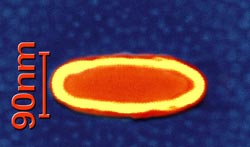Extremely fast MRAM data storage within reach

Electron-microscopic recording of an MRAM storage cell (Fig.: PTB)<br>
Magnetic Random Access Memories (MRAM) are the most important new modules on the market of computer storage devices. Like the well known USB-sticks, they store information into static memory, but MRAM offer short access times and unlimited writing properties. Commercial MRAMs have been on the market since 2005.
They are, however, still slower than the competitors they have among the volatile storage media. An invention made by the Physikalisch-Technische Bundesanstalt (PTB) changes this situation: A special chip connection, in association with dynamic triggering of the component, reduces the response from – so far – 2 ns to below 500 ps. This corresponds to a data rate of up to 2 GBit (instead of the approx. 400 MBit so far). Power consumption and the thermal load will be reduced, as well as the bit error rate. The European patent is just being granted this spring; the US patent was already granted in 2010. An industrial partner for further development and manufacturing such MRAMs under licence is still being searched for.
Fast computer storage chips like DRAM and SRAM (Dynamic and Static Random Access Memory) which are commonly used today, have one decisive disadvantage: in the case of an interruption of the power supply, the information stored on them is irrevocably lost. The MRAM promises to put an end to this. In the MRAM, the digital information is not stored in the form of an electric charge, but via the magnetic alignment of storage cells (magnetic spins). MRAMs are very universal storage chips because they allow – in addition to the non-volatile information storage – also faster access, a high integration density and an unlimited number of writing and reading cycles.
However, the current MRAM models are not yet fast enough to outperform the best competitors. The time for programming a magnetic bit amounts to approx. 2 ns. Whoever wants to speed this up, reaches certain limits which have something to do with the fundamental physical properties of magnetic storage cells: during the programming process, not only the desired storage cell is magnetically excited, but also a large number of other cells. These excitations – the so-called magnetic ringing – are only slightly attenuated, their decay can take up to approx. 2 ns, and during this time, no other cell of the MRAM chip can be programmed. As a result, the maximum clock rate of MRAM is, so far, limited to approx. 400 MHz. Until now, all experiments made to increase the velocity have led to intolerable write errors. Now, PTB scientists have optimized the MRAM design and integrated the so-called ballistic bit triggering which has also been developed at PTB. Here, the magnetic pulses which serve for the programming are selected in such a skilful way that the other cells in the MRAM are hardly magnetically excited at all. The pulse ensures that the magnetization of a cell which is to be switched performs half a precision rotation (180°), while a cell whose storage state is to remain unchanged performs a complete precision rotation (360°). In both cases, the magnetization is in the state of equilibrium after the magnetic pulse has decayed, and magnetic excitations do not occur any more.
This optimal bit triggering also works with ultra-short switching pulses with a duration below 500 ps. The maximum clock rates of the MRAM are, therefore, above 2 GHz. In addition, several bits can be programmed at the same time which would allow the effective write rate per bit to be increased again by more than one order. This invention allows clock rates to be achieved with MRAM which can compete with those of the fastest volatile storage components.
ptb/es
Contact at PTB:
Dr. Bernhard Smandek, PTB Technology Transfer,
phone: +49(0)531 592-8303,
e-mail: bernhard.smandek@ptb.de
Media Contact
More Information:
http://www.ptb.deAll latest news from the category: Physics and Astronomy
This area deals with the fundamental laws and building blocks of nature and how they interact, the properties and the behavior of matter, and research into space and time and their structures.
innovations-report provides in-depth reports and articles on subjects such as astrophysics, laser technologies, nuclear, quantum, particle and solid-state physics, nanotechnologies, planetary research and findings (Mars, Venus) and developments related to the Hubble Telescope.
Newest articles

Superradiant atoms could push the boundaries of how precisely time can be measured
Superradiant atoms can help us measure time more precisely than ever. In a new study, researchers from the University of Copenhagen present a new method for measuring the time interval,…

Ion thermoelectric conversion devices for near room temperature
The electrode sheet of the thermoelectric device consists of ionic hydrogel, which is sandwiched between the electrodes to form, and the Prussian blue on the electrode undergoes a redox reaction…

Zap Energy achieves 37-million-degree temperatures in a compact device
New publication reports record electron temperatures for a small-scale, sheared-flow-stabilized Z-pinch fusion device. In the nine decades since humans first produced fusion reactions, only a few fusion technologies have demonstrated…





















